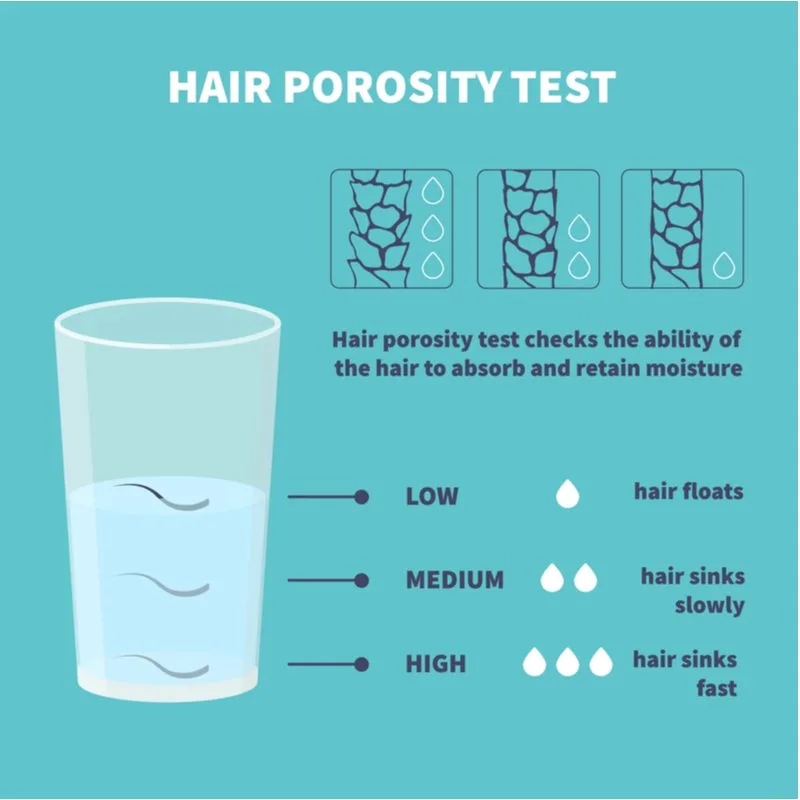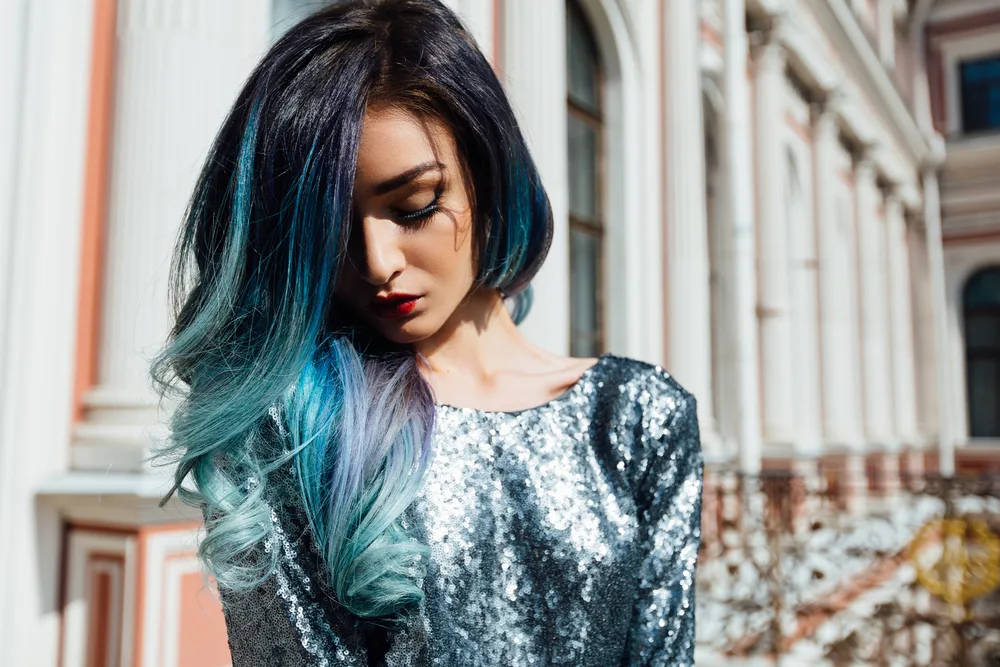Jump to:
Many people pass on brightly colored hair because they don’t want to damage their hair with chemicals getting it light enough to dye. In this article, you’ll learn how to dye dark hair blue without bleaching.
Dyeing without bleach isn’t just for those with light-colored hair! In recent years the market has become saturated with products designed just for dark hair to add splashes of color.
Using pigment to color your hair without the harsh chemicals saves your hair from damage with the added perk of washing out quickly.
There are ways to maintain your dyed hair to keep that color, which we’ll cover, but pigment dyeing is a great way to try multiple colors with minimal damage to your hair!
Dyeing Dark Hair Blue Without Bleach: A Summary

Korbut Ivetta/Shutterstock
To dye dark hair blue without bleaching is easier than you may think. We’ve broken it down into 5 easy steps.
- Determine your hair type
- Pick your product
- Prep your hair
- Apply product
- Rinse, enjoy, and maintain
Now that you’ve learned the basics, we’ll cover each step in detail in the next section, including how to deal with tricky-to-dye hair.
How to Dye Dark Hair Blue Without Bleaching in 5 Easy Steps
Skip the bleach and get right to the dye! Let’s dive into this relatively easy process to get the desired results.
1. Determine your Hair Type
An essential first step, identifying your hair type, will help you choose the type of product that works best for you. Some hair types may even need a little extra care to get the dye to hold.
Since we’ll be using pigment placing products without chemical lighteners, porosity will be the most important factor to consider. All hair has tiny holes, not visible to the human eye, on the top layer of each strand called the cuticle.
The size and number of these holes determine the porosity of your hair. Porosity measures how much moisture hair absorbs. Hair with high porosity soaks up moisture and products with ease.
However, high porosity hair can sometimes lose color quickly. Lots of conditioning helps high porosity hair hold color.
Low porosity hair can prove difficult to dye since the pigment particles can’t penetrate past the cuticle. Heat treatments help low porosity hair by opening up the cuticle. Brushing your hair out and getting a trim before dyeing can also help with this problem.
How to Determine Hair’s Porosity

art4stock/Shutterstock
You can perform a simple test at home to determine your hair’s porosity. All you’ll need is clean hair and glass water. Fill your glass with water and drop a single strand of clean, dry hair in the glass.
A strand of low porosity will float on the top for some time before sinking, while a high porosity strand will sink to the bottom of the glass. It’s possible to be in the middle of these two extremes with hair of medium porosity that stays in the middle of the glass.
You can also look at the characteristics of your hair to determine the porosity. Low porosity hair takes longer to soak in hair products, and it will take longer for your hair to get wet and dry.
If your hair has taken in color well in the past, your hair may be of medium or regular porosity. Normal porosity hair has a shiny, healthy look and is easy to style and dry.
High porosity hair tends to break easily and can be frizzy or dry in texture. Your hair may have high porosity if it dries quickly and absorbs product quickly into your hair. Or, you can take our “Is My Hair Porous? Quiz!“
Can You Change Hair’s Porosity?
Part of what determines your hair’s porosity is genetics. How your hair grows naturally can’t be altered, but you can use different products to affect your hair’s porosity.
Maintain low porosity by using light products that are less likely to cause build-up. Using heat and applying products to wet hair can also help the strands to retain more moisture.
High porosity hair can handle heavier products to retain your hair’s moisture. Using less heat when styling and bathing can be beneficial for this hair type.
2. Pick Your Product
Many products on the market today don’t require your hair to be bleached before use. Look for dyes that deposit pigments into your hair without lightening chemicals.
Certain brands have formulated dyes for people with hair that is already dark. Using products specifically made for darker hair will help you find the best solution for your blue hair goals.
Remember your hair type from the first step? Your hair’s porosity should influence the dye you choose to color your hair. People with high-porosity hair should use a dye that helps seal in moisture.
Consider a creme or conditioner-based dye when coloring your high porosity hair. Folks with low porosity hair don’t need to look for a specific type of dye but may want to take extra preparations before applying the color and during the process.
3. Prepare Your Hair
No matter your hair’s porosity, you’ll want to give it a good wash before beginning the dyeing process. Hair has natural oils to protect it from the elements, but these oils can also interfere with adding color.
A trim can help your hair soak up more color too. Cutting off your split ends helps by removing damaged hair, which loses color faster. A cut helps to open up the cuticles for those with low porosity hair too.
If you determined your hair has low porosity, you might want to consider heating your hair at this point. Use a hair dryer to blow out your hair with the heat on. The heat helps to open up the microscopic holes in your hair to accept more pigment.
4. Apply Your Product
Before applying your dye, consider the two options for application. After washing your hair in the preparation step, you can leave your hair dry or wet. Leaving your hair wet will help to lessen the intensity of your chosen color.
If you’re looking for a subtle look, apply your hair dye while the hair is still damp. On the other hand, waiting for your hair to dry or blow drying helps it to pick up more color.
For the most vibrant colors, add blue dye to your dark hair while it’s dry. Follow the specific directions of your product, as some will vary slightly. For most formulas, you’ll want to leave the product in at least thirty minutes.
Adding extra time can help hair soak up more pigment, but be careful. Leaving the product in for too long can damage hair. If you chose a pigment-based dye without any lightening chemicals, this shouldn’t be a problem.
But if you opted for a demi-permanent color leaving the dye in for too long could hurt your hair. For the best coverage, comb the dye through your hair.
Sectioning your hair while pulling the pigment through with a comb is the best way to achieve an even coating for consistent color. Brushing the dye through can also help absorb the dye into low porosity hair.
Another way to ensure low porosity hair accepts the blue dye is to do an additional heat treatment. Blow drying your hair while the dye is setting or even sunning your hair outside while you wait can help the color to take hold.
5. Rinse, Enjoy, and Maintain

vhpicstock/Shutterstock
Rinse the dye out of your hair using cool water at this point may help to hold in color. Let your hair dry naturally or blow dry on a cool setting and enjoy your new blue hair! Maintain your hair color for the longest-lasting results.
We have several tips for preserving color after dyeing your hair. We’ve talked about how heat affects porosity and how applying heat opens up the cuticles to accept pigments.
The same rule applies here, but you’ll be using it for the opposite effect. Washing your hair with cool or lukewarm water will keep your hair’s porosity higher, allowing the color to stay in your hair longer.
The same goes for your styling tools. Try forgoing heat styling or using your tools on a lower setting to help to maintain your dark hair’s blue hue. Wash your hair less than you usually would.
Each wash will remove dye from your hair. Many companies offer products specifically to keep your color. So consider picking up some products designed for color-treated hair.
In addition to shampoo and styling products, some companies offer conditioners with color pigments to refresh your color. Using these types of products can help to maintain your blue color.
Even though you didn’t lighten your hair with chemicals, it’s a good idea to do a deep conditioning treatment after dyeing. This step is crucial for those with high porosity hair to seal in moisture and color.
Read Next: How Long Does Purple Hair Dye Last?
Frequently Asked Questions
These are some of the most frequently asked questions about dyeing dark hair blue. If you have a question we haven’t answered yet, check out our answers to these questions.
What color does your hair have to be to dye it blue?
For the most vibrant blues light colored hair is easiest to dye, but your hair doesn’t have to be this color. People with dark hair now have a wide range of products to choose from to add cerulean tones to their hair without the hassle and damage of dyeing.
How can I dye my hair blue without it turning green?
Green hair usually results from fading dye revealing yellow tones in your hair. The best way to keep your desired color is to maintain your dyed hair, as explained in step five of this tutorial. Consider adding a purple shampoo to your hair care routine to diminish the appearance of yellow tones in your hair.
How long does blue last in hair?
How long your blue hair will last depends upon several variables. Most products stay a few weeks but some last longer, especially with proper maintenance. If you wash or heat style your hair frequently, expect the blue dye to fade out more quickly from your hair.
What will blue shampoo do to hair?
Blue shampoo works in the same way as purple shampoo. It lessens the appearance of certain tones in your hair. The purple shampoo helps remove yellow tones, while the blue shampoo removes brassy tones.
Does blue-black hair require bleach?
There are blue-black hair dyes designed for dark hair with no bleach required! If your hair is already black, you might be able to achieve this look by just adding blue to your hair, but the blue-black color does come in many varieties.
So, How Do You Dye Dark Hair Blue Without Bleach?
Identifying your hair type and choosing the best product and procedure allows you to dye your dark hair blue without bleaching it. We expect to see even more products emerge on the market for this type of hair dyeing!
